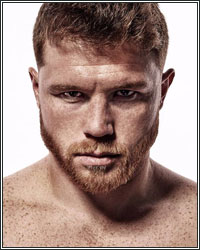
If there’s anyone who should understand Saul “Canelo” Alvarez and the Mexican’s no-win career dilemma, it’s Alvarez’s promoter Oscar De la Hoya.
Nearly 20 years ago, it was the Golden Boy Promotions president and founder who could do no right in the eyes of many hardcore boxing fans. De la Hoya had every big win marginalized and every bad moment magnified. If the fight was close, he was the beneficiary of a bogus decision; if he dominated, the opponent was never any good, anyway. There was always some scary conqueror lying in wait, ready to beat the pretty off of the hand-fed fake fighter. And when he would slay the beast, there would always be another monster propped up—this one more fierce than the last and even more likely to expose “The Golden Boy.”
The Mexican-American star was just too crossover-friendly, too good-looking, too fresh and clean. He sported no battle scars and, as a matter of fact, never even really went to battle until much later in his career. He was the antithesis of everything the hardcore fight fan embraces as part of boxing mythology.
As a result of this dynamic, De la Hoya made a ton of money with his mainstream appeal, but never really won over the fans. And even, to this day, he’s not regarded as a true great, despite a Hall of Fame career that saw him world titles in six different divisions.
Canelo Alvarez faces the same obstacles as De la Hoya.
The red-headed, freckled native of Guadalajara, Jalisco, Mexico doesn’t look the part of a battle-hardened champ and has definitely been given a career boost here and there because of his crossover, mainstream appeal.
Alvarez was gifted the WBC junior middleweight title in 2011 when he was allowed to beat welterweight Matthew Hatton for the belt. He followed that dubious victory with soft-touch defenses against the likes of Ryan Rhodes, Alfonso Gomez, and a faded Kermit Cintron.
Right around the summer of 2012, though, things changed for Alvarez with a conscious effort being made to amp things up and start doing things right. He signed on to face the much-avoided Paul Williams in a bout that had to be cancelled after Williams’ career-ending motorcycle accident. He pursued a bout with James Kirkland, back when Kirkland was still very much considered a feared “beast.”
From spring 2013 to fall 2015, you would’ve been hard-pressed to find a fighter with a tougher, more complex set of opponents as Alvarez faced tricky boxers Austin Trout and Erislandy Lara; sluggers Alfredo Angulo and James Kirkland; and Hall of Fame superstars Floyd Mayweather and Miguel Cotto.
And this was all done at the request of Alvarez, himself, because Alvarez, unlike De la Hoya, bristles at the idea of being considered “less” of a fighter. A paycheck simply isn’t enough for this kid who covets the respect of those Mexican fans who embrace warriors like Julio Cesar Chavez Sr. and Salvador Sanchez as icons and real world superheroes. Alvarez wants legendary status and there’s no frivolous star-tripping in his being, unlike De la Hoya, who partied just as hard as he trained and took great advantage of being a money-earner who would get the benefit of most doubts outside the ring.
But the deep and respectable six-fight run for Alvarez did nothing to earn him respectability in the eyes of the hardcore boxing fans he so wanted to convince.
Then came Gennady Golovkin.
HBO had been working to manufacture stardom for Golovkin for more than three years before he was wedged into the role of Canelo’s Boogeyman. However, the heavy-handed Kazakh, a hit among many hardcore fans, was barely more than a blip on the radar when it came to much-needed mainstream crossover appeal. In order for HBO and Team Golovkin to get their ultimate payoff (and payday), they needed to piggyback off of another star’s drawing power—and Alvarez fit that bill, perfectly.
To achieve this end, Team Golovkin played the media like a fiddle and, by extension, played the fans for suckers. Alvarez was dragged through the mud by the media for balking at being asked to take all the risk AND have to bring all the money to the table for a proposed bout.
And, despite a brief sprint of money grabs that saw him fight Amir Khan, Liam Smith, and Julio Cesar Chavez Jr., Alvarez could not resist the challenge to his manhood.
Still the fighter bringing most of the money and assuming all of the risk, Alvarez has given in to the full-scale media push, ultimately, because he wants so desperately to win that respectability as a “real” fighter he has been so slow to receive.
A more pragmatic Canelo Alvarez might still be taking lower-risk challenges, stringing Golovkin along, and forcing the “B-side” to jump through some more hoops before earning a shot at this kind of payday. But the 27-year-old wants to become this era’s Chavez and the kind of fighter guys like “Nacho” Beristain and Juan Manuel Marquez publicly embrace. He burns for respectability and a spot among the all-time Mexican greats.
De la Hoya, showing a complete lack of empathy for his fighter’s recognizable career plight, put this Golovkin fight off as long as possible, but there was never any doubt that it would be made.
Forget the styled red hair, the garish hipster clothing, and well-manicured public image-- Canelo Alvarez is a REAL man and a REAL fighter at heart. When push came to shove, this fight was always a guarantee to happen.
Now, whether that’s enough to get him a win against Gennady Golovkin this coming September 16, well, that remains to be seen.









